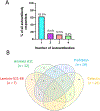Disease Severity Linked to Increase in Autoantibody Diversity in IgG4-Related Disease
- PMID: 31612628
- PMCID: PMC7113109
- DOI: 10.1002/art.41140
Disease Severity Linked to Increase in Autoantibody Diversity in IgG4-Related Disease
Abstract
Objective: Four autoantigens have been described recently in IgG4-related disease (IgG4-RD): prohibitin, annexin A11, laminin 511-E8, and galectin-3. However, no external validation has been performed, and the possibility that some individuals break tolerance to more than 1 autoantigen has not been explored. We undertook this study to evaluate the relative frequencies of antibody responses against these autoantigens in order to explore the role of adaptive immune response in IgG4-RD.
Methods: Autoantibody responses against prohibitin, annexin A11, and laminin 511-E8 were measured among a clinically diverse cohort of IgG4-RD patients (n = 100) using enzyme-linked immunosorbent assays. Autoantibody responses were correlated with disease severity and organ distribution.
Results: The frequencies of IgG4 autoantibody responses against prohibitin (10%), annexin A11 (12%), and laminin 511-E8 (7%) were not significantly different from those of controls. A portion of the cohort (n = 86) had been analyzed previously at our center for anti-galectin-3 antibody responses, with 25 patients (29%) having IgG4 anti-galectin-3 antibodies. Of these 86 patients, 32 (37%) had IgG4 antibodies to ≥1 of the 4 autoantigens and 12 (14%) showed reactivity with ≥2 of the tested antigens. The subset of patients with ≥2 autoantibodies had higher total levels of IgG1, IgG2, IgG4, and C-reactive protein, were more commonly hypocomplementemic, and were more likely to have visceral organ involvement.
Conclusion: Antibodies against prohibitin, annexin A11, and laminin 511-E8 were found in only a small portion of patients with IgG4-RD. A subset of IgG4-RD patients, however, had IgG4 antibodies against ≥2 autoantigens. These patients presented with robust IgG subclass elevations, complement consumption, and visceral organ involvement. This broader break in immunologic tolerance in IgG4-RD was associated with more severe disease.
© 2019, American College of Rheumatology.
Figures




Comment in
-
Different Frequencies of Antibody Responses in IgG4-Related Disease: Comment on the Article by Liu et al.Arthritis Rheumatol. 2020 Sep;72(9):1584-1585. doi: 10.1002/art.41393. Epub 2020 Jul 21. Arthritis Rheumatol. 2020. PMID: 32524742 No abstract available.
-
Reply.Arthritis Rheumatol. 2020 Sep;72(9):1585-1586. doi: 10.1002/art.41389. Epub 2020 Jul 20. Arthritis Rheumatol. 2020. PMID: 32524774 No abstract available.
-
Antiphospholipid Syndrome Is Still a Rare Disease-Estimated Prevalence in the Piedmont and Aosta Valley Regions of Northwest Italy: Comment on the Article by Duarte-García et al.Arthritis Rheumatol. 2020 Oct;72(10):1774-1776. doi: 10.1002/art.41401. Epub 2020 Sep 6. Arthritis Rheumatol. 2020. PMID: 32840055 No abstract available.
-
Reply.Arthritis Rheumatol. 2020 Oct;72(10):1776. doi: 10.1002/art.41398. Epub 2020 Sep 2. Arthritis Rheumatol. 2020. PMID: 32869535 No abstract available.
References
Publication types
MeSH terms
Substances
Grants and funding
LinkOut - more resources
Full Text Sources
Research Materials
Miscellaneous

